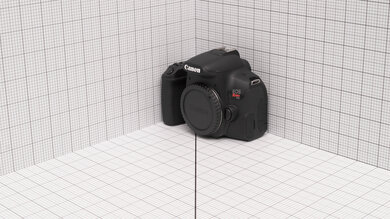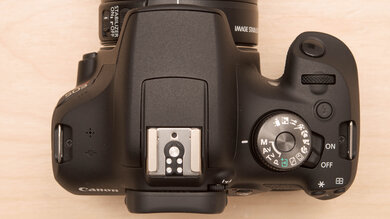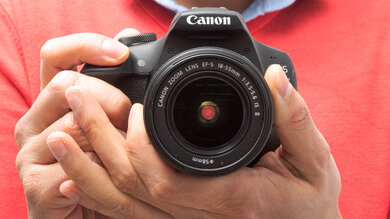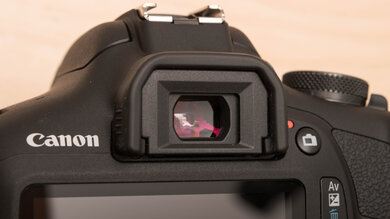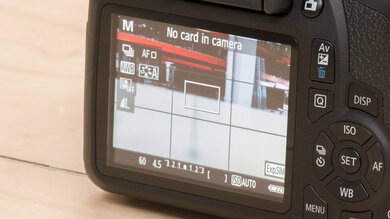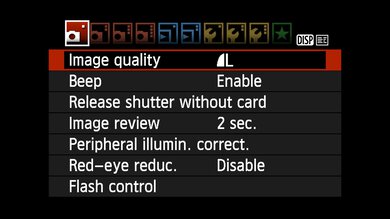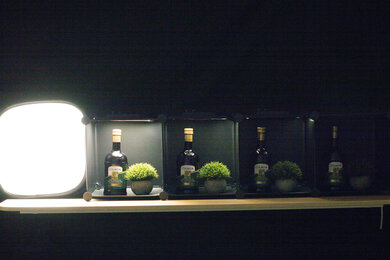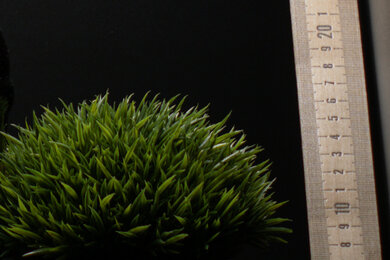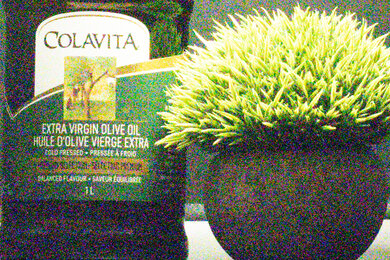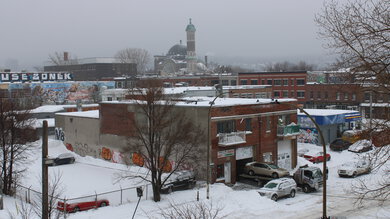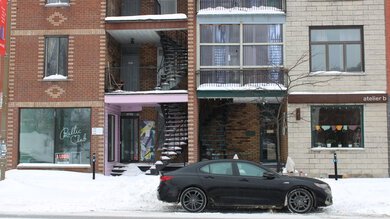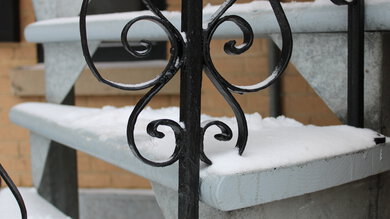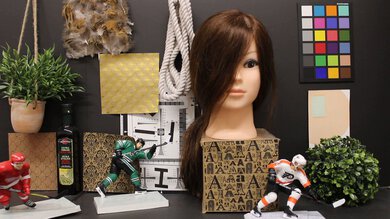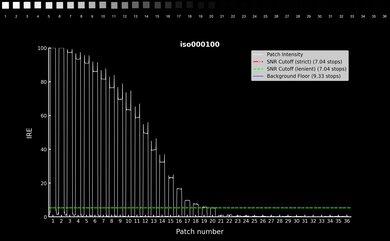The Canon EOS Rebel T7/2000D is an entry-level DSLR. It's the cheapest and simplest model in Canon's DSLR lineup, with a very basic design and little in the way of extra features. It has a 24-megapixel APS-C sensor, an upgrade over its predecessor, the Canon EOS Rebel T6/EOS 1300D, but otherwise, it doesn't offer any major improvements to the formula. That's not bad for those looking for a simple and affordable DSLR for photography, but don't expect features that have become commonplace on cameras, like an articulated touchscreen or 4k video capability.
Our Verdict
The Canon Rebel T7 is okay for travel photography. The camera captures good image quality overall, especially if you're coming from a smartphone. It's bulkier than mirrorless alternatives, and its autofocus system is very rudimentary. Its battery life isn't as good as higher-end DSLR cameras, but it's still good overall and better than a lot of mirrorless options. And despite a somewhat cheap-feeling build quality, the camera at least feels comfortable to shoot with.
- Good image quality for its class.
- Decent ergonomics.
- Solid battery life for photography.
- Cheap-feeling construction.
- Mediocre autofocus performance.
- Not the most portable.
The Canon Rebel T7 is adequate for landscape photography. Its image quality falls short of full-frame or higher-end APS-C cameras, but it's still very solid for its class. Though its dynamic range is unremarkable, you can still get great landscape shots out of it, especially with good lighting conditions and high-quality lenses. The camera is also fairly comfortable to use, with simple controls tailored towards beginner photographers, though more advanced shooters may find the lack of control dials limiting. Unfortunately, it also feels quite cheaply made and isn't weather-sealed.
- Good image quality for its class.
- Decent ergonomics.
- Solid battery life for photography.
- Cheap-feeling construction.
- Not the most portable.
- Mediocre dynamic range.
The Canon Rebel T7 isn't well-suited for sports and wildlife photography. It has a very slow burst rate, making it much harder to capture distinct images of fast-moving subjects, and its photo buffer isn't very deep, especially when shooting in RAW format. While the camera has a face-tracking feature, it struggles to keep up with faster subjects and can't focus on the edges of the frame. Its plastic construction also doesn't feel as solid as more expensive models. On the upside, the image quality is good for its class.
- Good image quality for its class.
- Decent ergonomics.
- Cheap-feeling construction.
- Mediocre autofocus performance.
- Slow burst rate.
The Canon Rebel T7 is a poor fit for vlogging, though this isn't its intended use. It's limited to 1080p recording, and its screen is fixed, so you can't see yourself when the camera's facing you. It's also bulkier than mirrorless alternatives, making it a hassle to carry around for on-the-go vlogs. Its video quality isn't especially impressive either, with videos having a somewhat grainy quality, and its autofocus system doesn't offer continuous tracking while shooting video.
- Easy to use menu system.
- No 4k recording.
- Poor recording quality in 1080p.
- Fixed screen can't be seen when camera is pointed at you.
- No continuous tracking autofocus while recording video.
The Canon Rebel T7 isn't meant for studio video. It can only record video in 1080p, and its overall video quality is disappointing. It also has a limited selection of ports, with no microphone or headphone jack. Its autofocus system also doesn't support continuous tracking in video, making it difficult to maintain focus on moving subjects.
- Easy to use menu system.
- No 4k recording.
- Poor recording quality in 1080p.
- Limited selection of inputs and outputs.
The Canon Rebel T7 isn't designed for action video. It's too big to be mounted on a helmet or chest rig and isn't weather-sealed. It also doesn't support 4k recording or continuous AF tracking in video mode, and it can't record at high-speed frame rates for smooth action video or slow-motion footage.
- Easy to use menu system.
- Cheap-feeling construction.
- No 4k recording.
- No high frame rate options.
The Canon Rebel T7 has okay RAW photo performance. Its noise handling is decent in low light, but it has a limited ISO range, so you'll need to either slow down your shutter speed or use a wide-aperture lens to get great results in darker settings. Images look fairly detailed and decently sharp, thanks to the sensor's high resolution. However, the sensor's dynamic range is somewhat limited, so you'll lose some highlight or shadow detail in high-contrast scenes.
- Fairly high resolution.
- Decent noise handling for its class.
- Limited ISO range.
- Dynamic range is just okay.
Performance Usages
Changelog
-
Updated Dec 12, 2024:
We wrote text for the new tests added in Test Bench 0.13 and updated the Verdict section accordingly.
- Updated Dec 12, 2024: We've converted this review to Test Bench 0.13. We've added new tests for Video Dynamic Range and Luminosity Patch Detection. You can learn more about these updates in the changelog.
- Updated Oct 09, 2024: We went over this review to ensure the information is still current, adjusting some of the text throughout for clarity. We also updated the Advertised Battery Life In Photo comparison with the battery life stated in the camera's user manual and updated the corresponding text in the review.
- Updated Jan 29, 2024: Added text to the 'Raw Photo Performance' verdict box.
Check Price
Differences Between Sizes And Variants
The Canon Rebel T7 is only available in one color: 'Black.' Here's our unit's label.
This camera is sold as the Rebel T7 in the North American market, the Kiss X90 in Japan, the 1500D in southeast Asia, and the EOS 2000D elsewhere. You can buy the camera body on its own or bundle it with the Canon EF-S 18-55mm f/3.5-5.6 IS II kit lens.
Popular Camera Comparisons
The Canon EOS Rebel T7/2000D is a simple budget DSLR. It has a 24-megapixel APS-C sensor, basic controls, and a fixed screen. Though build quality leaves a lot to be desired, the sensor is still decent for a starter camera, and there are plenty of excellent EF and EF-S lenses to choose from if you want to step up the quality of your photos. That said, compared to modern mirrorless cameras like the Canon EOS R50, its autofocus system is very limited, and it can't record 4k video. Stepping up to the latest Rebel 'i' model, the Canon EOS Rebel T8i will get you a noticeably better sensor and AF system, as well as 4k video capability, but it's also a pricier camera.
If you're looking for more options, you can also check out our recommendations for the best DSLR cameras for beginners, the best cheap and budget cameras, or the best DSLR cameras overall.
The Canon EOS Rebel T7/2000D and the Canon EOS R100 are both beginner-oriented cameras with different designs, but ultimately, the newer R100 offers a much wider breadth of capability. The mirrorless R100 is smaller and lighter, feels better built, has a brighter and sharper display, and has a more intuitive menu system. It also has a much more effective autofocus system, plenty of automatic scene shooting modes, and can record 4k video, albeit with a severe crop and a max frame rate of 24 fps. While the Rebel T7 has Canon's EF/EF-S lens mount, which currently offers a much wider array of budget-friendly lenses, you can always use them with an R100 via an EF-EOS R lens mount adapter, although that comes at an additional cost and some added bulk.
The Canon EOS R50 is better than the Canon EOS Rebel T7/2000D. It uses newer mirrorless technology, with a more advanced and effective autofocus system, a sensor that captures slightly better overall image quality, and significantly quicker burst shooting. In addition, it has much more advanced video features, including 4k recording capability.
The Nikon D3500 is better overall than the Canon EOS Rebel T7/2000D. While both are entry-level cameras with some of the same limitations, the D3500 has a better sensor, resulting in slightly better overall image quality. It also has a faster max burst rate, a significantly longer battery life, and a built-in 'Guide Mode' to walk beginners through the basics of photography.
The Canon EOS M50 is better overall than the Canon EOS Rebel T7/2000D. It has some extras that you don't get with the T7, like a fully articulated touchscreen and 4k video capability. It's also more portable. That said, the M mount is a mostly defunct lens ecosystem, whereas the EF/EF-S mount has a wider range of lens options available.
Test Results

The Canon Rebel T7 isn't the most compact, especially compared to mirrorless alternatives like the Canon EOS R50. However, it's still fairly portable overall and less bulky than full-frame DSLRs like the Canon EOS 6D Mark II.
The Canon Rebel T7 has a plastic exterior. While it doesn't feel as premium as pricier models like the Canon EOS Rebel T8i, it's solid overall. The buttons also provide decent physical feedback, though they can be slightly sluggish to respond to inputs. The camera also isn't weather-sealed.
The camera feels decently comfortable in the hand, though the grip is a little on the smaller side for those with very large hands. The rubberized texture around the hand grip feels nice and secure, though, and the thumb rest is well-placed. The simple controls and single command dial are well-suited to novice users but make it harder to adjust settings on the fly when shooting in manual mode.
The camera uses a fixed screen, making it harder to take photos from waist level or shoot from different angles. It doesn't get overly bright, and its resolution doesn't provide the sharpest image to review your photos accurately. Unlike the Canon EOS Rebel SL3 or the Canon EOS Rebel T8i, there's also no touch capability, so you have to use the directional pad to navigate the menu and adjust the focus point.
The user interface is quite simple and easy to use. However, it's less intuitive than the menus on newer Canons like the Canon EOS Rebel T8i. For instance, not all settings are available at all times. You need to be in video mode to adjust video settings, and certain options are only accessible either in Live View mode or when shooting through the viewfinder.
Battery life isn't too bad on the Canon T7. It's CIPA-rated for approximately 600 shots on a full charge when shooting through the viewfinder with no flash, or 500 shots when using flash 50% of the time. Conversely, shooting in Live View, rather than through the viewfinder, drops that CIPA rating down to 260 shots with no flash or 240 shots when using flash 50% of the time. Based on the numbers, the T7 isn't nearly as good as Canon DSLRs with higher-capacity batteries, like the Canon EOS Rebel SL3, though it's better overall than most entry-level mirrorless cameras. However, CIPA ratings don't necessarily translate into real-world usage. Your mileage will vary depending on your shooting habits, settings, and environment.
The camera's video battery life isn't great. You'll get roughly an hour of continuous video recording in FHD, as the camera can't record in 4k. Video isn't this camera's forte, though, so this isn't too surprising.
The Canon Rebel T7 has a slow max burst rate and can only shoot at one speed, making it harder to capture sequential bursts of fast-moving subjects. It also has a very small photo buffer, especially if you're shooting in RAW format. If you max out the buffer, it also takes a little while to empty before you can start shooting again.
The Canon Rebel T7 has a pretty basic autofocus system. It includes a face detection feature that can detect and focus on faces in single shooting mode. However, it lacks the Dual Pixel Autofocus found on higher-end Canon DSLRs like the Canon EOS Rebel T7i or the Canon EOS Rebel T8i. That means there's no continuous tracking function that can actively track and maintain focus on moving subjects while shooting continuously.
While there's no algorithm-based tracking on this camera, it still has continuous autofocus (called 'AI Servo' on Canon cameras), which does well at keeping up with any subject underneath your chosen focus point. The camera is limited to a small cluster of focus points around the center of the frame, making it harder to shoot subjects off-center. If you keep your subject framed in the center, however, the camera does an excellent job of keeping the target in focus.
There's no in-body image stabilization on the T7, so you'll have to rely on optically stabilized lenses to get stable shots at slower shutter speeds. Still, the optical stabilization in Canon EF and EF-S lenses works quite well, allowing you to capture clear shots at slow shutter speeds. That said, stabilization performance can vary depending on your lens, its focal length, weight, and even the steadiness of your hands. We tested it using the Canon EF-S 18-55mm f/3.5-5.6 IS II lens.
The camera's dynamic range is okay. It can't capture a very wide array of detail in high-contrast scenes, so you'll lose some shadow or highlight detail in trickier lighting conditions.
The camera's sensor has a fairly high resolution, capturing decently sharp images, but you lose some finer details and textures. However, this is most apparent when cropping or pixel-peeping.
The noise handling is decent, considering the camera's class, though noise quickly becomes more apparent in trickier lighting conditions. The camera maxes out at ISO 6400, so its low light capability is limited compared to newer cameras with higher ISO settings. That means you'll have to rely on slower shutter speeds or faster lenses with wider apertures for really dim conditions.
The camera's video features are quite limited. It can only record video in full HD, without any extra or more advanced features like Log recording or even clean HDMI output.
This camera can't shoot 4k video. If you're looking for a similar Canon camera that can record in 4k, consider the mirrorless Canon EOS R100, but be aware that it can only record 4k with a significant crop.
Unfortunately, this camera doesn't include any high frame rate options for slow-motion or fast-action video. It can record 1080p video at up to 30 fps, so it's suitable for everyday video capture or more cinematic 24 fps video.
Internal recording is passable. Unfortunately, its maximum recording time is capped at 12 minutes, so you can't use the camera for longer continuous takes. Bit rates are also mediocre, meaning it can't capture a wide range of information for higher-quality videos.
The Canon Rebel T7 doesn't have an AF tracking mode in video, meaning it can't continuously track moving subjects as you record, though its face detection feature still works. That means it's best suited to talking head videos or videos where your subject stays in the same focal plane since you'll have to manually half-press the shutter to refocus whenever the subject moves. Using a more basic lens like the kit lens also results in very slow and noisy focusing, with a lot of pulsing and chasing, which isn't ideal for video recording.
Rolling shutter effect is fairly noticeable. It isn't terrible, but you'll see skewed vertical lines when panning the camera quickly.
The Canon T7 has poor dynamic range in video. Its video features are very limited, as it can only record in 8-bit 1080p, with no Log recording option and limited codec support. The resulting footage has a usable dynamic range of about 7 stops. It can technically capture a slightly higher max dynamic range, but those stops won't be clean, and you'll have very little flexibility to adjust your footage in post. Overall, the camera struggles to capture a wide range of high-contrast detail.
Tested settings:
- Resolution: 1080p
- Frame Rate: 30 fps
- Log Format: N/A
The camera's ports are limited. There's no mic input or headphone jack, though that isn't surprising given the camera's limited video capabilities. Otherwise, there's a Mini USB port for charging and file transfer and a Mini (Type C) HDMI port to connect to an external display. Unlike newer models, the camera doesn't support Bluetooth connectivity, though you can still wirelessly transfer photos to a phone over Wi-Fi.

